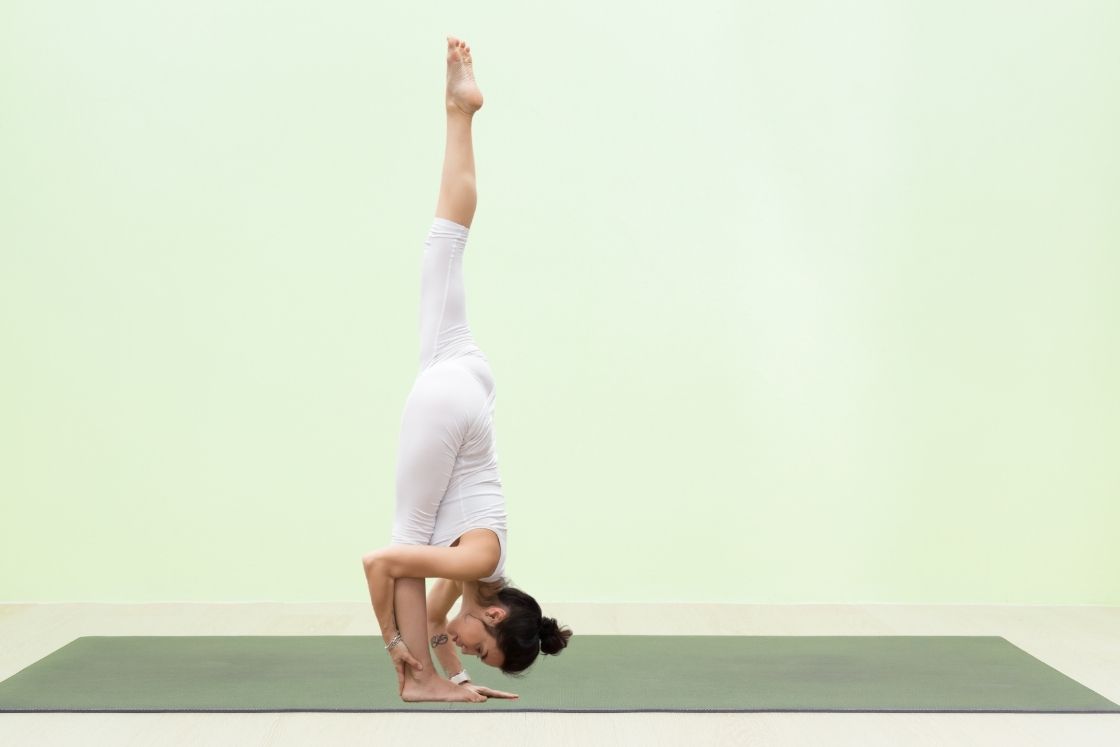
Standing one leg split or simply standing split is a standing balancing yoga posture. It’s an advanced hip opener yoga pose where one leg is extended upwards while maintaining the balance of forward fold body on another leg. It requires a lot of balance to hold the pose as the bodyweight is concentrated on one leg alone.
The intention behind the pose is stretching the legs and hips. One leg is extended upwards and the head comes below the chest level, it makes this an inversion pose.
Along with making the hamstrings flexible, it opens up the groin. The asana is well-suited for relieving stress and tension.
Meaning and Interpretation
In Sanskrit, it is known as Urdhva Prasarita Eka Padasana. To better comprehend the name of the asana look at its root terms. It includes the following five words:
- ‘Urdhva’ which means ‘upward’
- ‘Prasarita’ refers to “spread” or “expanded
- ‘Eka’ is ‘one’
- ‘Pada’ means ‘foot’
- ‘Asana’ refers to ‘pose.’
Standing one leg split by its name clarifies what the practitioner does in the pose. It requires shifting of body weight into one leg and expanding the other upwards.
It brings the body into inversion and the head comes below the heart. It stimulates the crown (Sahasrara) chakra that leaves the mind rejuvenated. The abdomen is also involved in maintaining the pose that activates the sacral chakra. It helps to maintain emotional stability.
Standing Split Pose Practice Guide
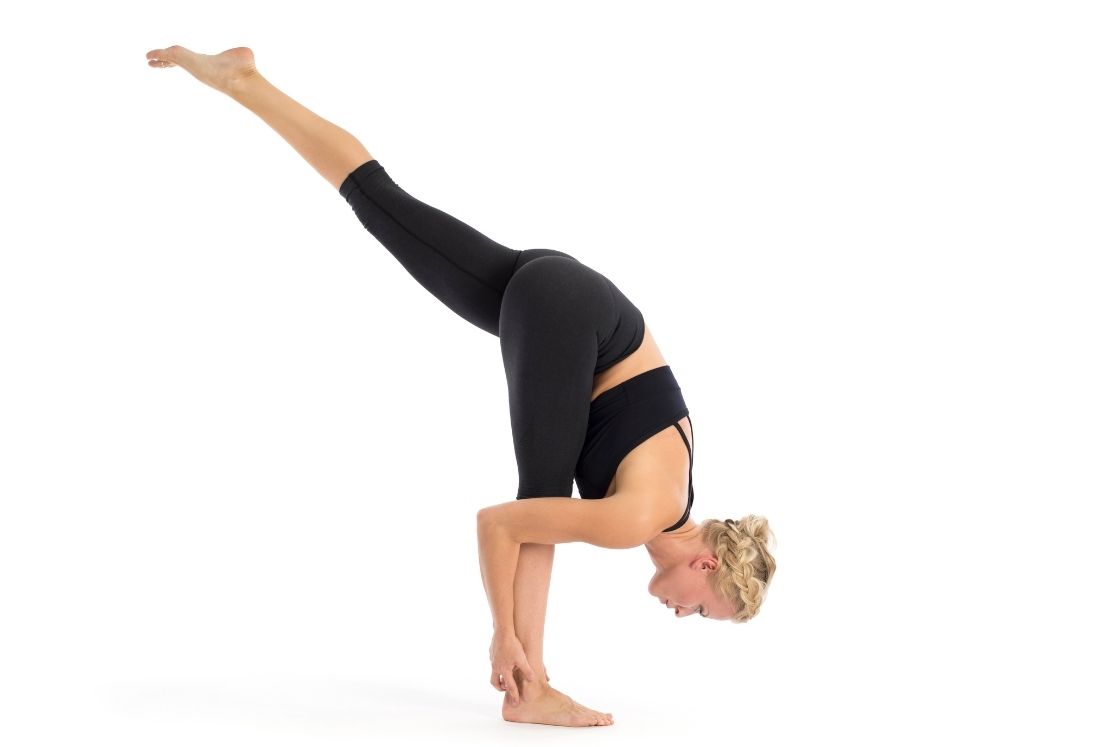
Before begin how to do standing split pose, go through the following points;
Contraindications
- Skip practicing Standing one leg split pose if you have high blood pressure. The balance required pressurizes the heart and is unsafe to perform with abnormal BP.
- Do not perform the asana with a torn muscle or tendon.
- Avoid it in case of an injury in knees, hips, lower back, ankles, shoulders, arms, or neck.
- Never perform the pose if you have sciatica.
- Do not practice the pose if there is a problem with a migraine.
Preparatory poses
- Standing Forward Bend (Uttanasana)
- Big Toe Pose (Padangusthasana)
- Wide-Legged Forward Bend Pose (Prasarita Padottanasana)
- Downward-Facing Dog (Adho Mukha Svanasana)
- Janu Sirsasana (Head-of-the-Knee Pose)
- Paschimottanasana (Seated Forward Bend)
- Supta Padangustasana (Reclining Big Toe Pose)
How to Do Standing Split Pose
- Stand in the mountain pose.
- Inhale and raise your arms overhead.
- Start bending forward at the hips as you exhale and bring your hands to the floor (Uttanasana).
- Keep your legs straight without straining the knees.
- Now, shift your weight on to the right foot as well as to the hands.
- try lifting the leg and extend it towards the ceiling.
- To deepen the stretch, walk your palms towards the standing heel.
- Take a deep breath and relax your shoulders.
- Tuck your chin and rotate the left thigh internally.
- Maintain the pose for five breaths.
- To release, bring the left leg to the floor and stay in Uttanasana.
- Repeat these steps switching the legs and shifting the weight to the left.
Beginner’s tips
- Before getting into standing one leg split pose spend time on warrior III pose.
- Use props to modify and balance your body in standing split pose. Some modifications are given below.
- Maintain the hip level evenly and do not push harder to increase the expanse of the lifted leg.
Precautions
- Do not lock the knees while keeping the legs straight. It may induce hyperextension to the knees.
- Focus on maintaining the proper alignment, as misalignment might cause internal injury.
- Always perform this pose after warming up the body with lunges and sun salutation, etc.
- Perform the asana by knowing your limits, do not rush into lifting the leg higher.
Follow up Pose
Relax the body after performing standing one leg split pose by performing cobra pose(Bhujangasana).
Standing Split Pose Modifications
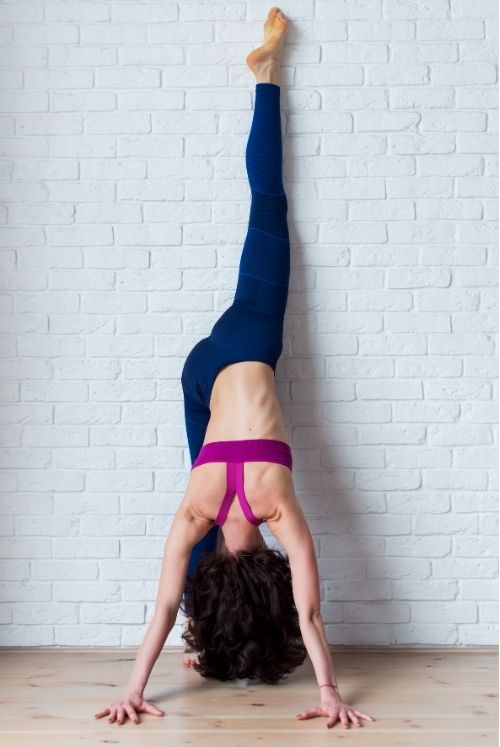
- Against the wall – Modify the standing one leg split pose by pressing the raised foot against the wall. It helps in maintaining the balance.
- Blocks – Bring two blocks in front of you as a helping prop. Keep your hands on them while bending forward and maintaining the pose instead of reaching the ground.
- Yoga strap – Make a loop of yoga strap and wrap it around the lifted foot. As you raise the foot, hold the other end of the strap with the respective hand. It provides the leg extra support.
Variations
- Instead of grabbing the standing heel, you can maintain the pose by keeping both the hands to the ground.
- When you achieve the pose fully, walk your palms outside. Try grabbing the lifted ankle with the respective hand.
Standing Split Pose Benefits
1. Enhances flexibility
The pose is great for stretching the muscles of the legs. The thighs, calves, and hamstrings experience the deep stretch when one leg extended upwards. Besides this, the upper body is also involved in the pose therefore it stretches the spine as well. This makes the body flexible.
2. Strengthens lower body limbs
The ankles, calves, and knees experience extreme pressure due to the concentration of body weight. It increases the strength of the lower body.
3. Regulates blood circulation
As standing split is also an inversion pose, its inversion action increases the surge of blood flow to upper organs. It improves blood circulation. The blood also reaches to the brain as the head and neck hang down.
4. Maintains mental health
Due to better circulation, the brain gets enough oxygen and clears all the mental blocks. It relieves any stress or tension and provides soothing effects to the nervous system.
5. Maintains Chakras balance
Standing one leg split pose also stimulates the energy chakras of the body. It activates the Root Chakra (Muladhara) and Sacral Chakra (Svadhisthana). This helps the practitioner to feel connected and improves balance. the sacral chakra improves the immune system.
Conclusion
Standing one leg split pose is best to challenge the potential of the body. It tunes the humans to themselves internally. Enter the advanced level of stretching by giving it a try.

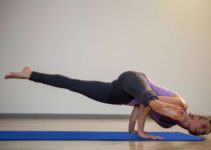

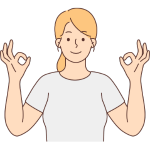
 Oct 24th to 30th
Oct 24th to 30th Learn Mudras
Learn Mudras  Deepen Your Practice
Deepen Your Practice  Find Inner Peace
Find Inner Peace